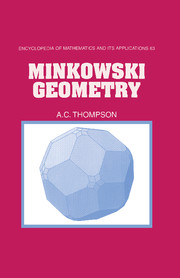Book contents
- Frontmatter
- Contents
- Preface
- Acknowledgements
- 0 The algebraic properties of linear spaces and convex sets
- 1 Norms and norm topologies
- 2 Convex bodies
- 3 Comparisons and contrasts with Euclidean space
- 4 Two-dimensional Minkowski spaces
- 5 The concept of area and content
- 6 Special properties of the Holmes–Thompson definition
- 7 Special properties of the Busemann definition
- 8 Trigonometry
- 9 Various numerical parameters
- 10 Fifty problems
- References
- Notation index
- Author index
- Subject index
3 - Comparisons and contrasts with Euclidean space
Published online by Cambridge University Press: 05 May 2013
- Frontmatter
- Contents
- Preface
- Acknowledgements
- 0 The algebraic properties of linear spaces and convex sets
- 1 Norms and norm topologies
- 2 Convex bodies
- 3 Comparisons and contrasts with Euclidean space
- 4 Two-dimensional Minkowski spaces
- 5 The concept of area and content
- 6 Special properties of the Holmes–Thompson definition
- 7 Special properties of the Busemann definition
- 8 Trigonometry
- 9 Various numerical parameters
- 10 Fifty problems
- References
- Notation index
- Author index
- Subject index
Summary
Euclidean space is, both historically and psychologically, our original idea of how a finite dimensional normed space behaves. The results of this chapter express in a variety of ways to what extent a Minkowski space is similar to, and how it differs from, a Euclidean space. There are three basic themes: (a) the group of isometries of the Minkowski space; (b) the notion of “perpendicularity” or “normality”; (c) the distance (in the sense of Banach–Mazur, Definition 2.4.6) to Euclidean space.
The chapter is divided into four sections. The first one is brief and presents the theorem of Mazur and Ulam, which states that any isometry of one normed space onto another one is necessarily linear. This is not true if the isometry is not surjective. It is not only a finite dimensional theorem but not usually prominent in books on functional analysis. The second section takes up the concept of normality. There is one main theorem but a variety of corollaries which indicate different ways of viewing the theorem. One is a geometric view stating that the unit ball in a Minkowski space (X, B) can be circumscribed by a parallelotope with certain properties. Another is an algebraic view that a Minkowski space (X, B) and its dual (X*, B°) have a pair of dual “orthonormal” bases. The third section is an important one. It contains the central theorem of Löwner that the unit ball in a Minkowski space has both an inscribed ellipsoid of maximal volume and a circumscribed ellipsoid of minimal volume and, more importantly, that these ellipsoids are unique.
Information
- Type
- Chapter
- Information
- Minkowski Geometry , pp. 75 - 98Publisher: Cambridge University PressPrint publication year: 1996
